Robot Arms Briefly Explained
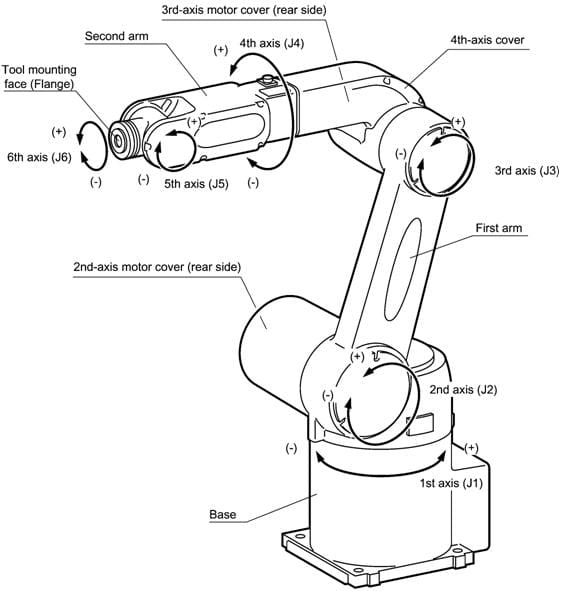
Robot arms have been used as industrial tools since their practical invention in 1969, and now they are becoming increasingly popular as DIY projects and tools for household use. With the advent of the Arduino microcontrollers in 2005, and the massive open source movement that followed, it should come as no surprise that the technology seen in car manufacturing plants should migrate to becoming programmable in-house assistants.
Typical Arduino robot arms — and robot arms in general — are rated in terms of degrees of freedom (DOF). This refers to the number of rotational joints contained within the design of the robot. This terminology is specific to robot arms, but also interchangeable with the more typical “axes“. For example, a 4DOF (4 Axis) robot arm will have four discrete axes of motion. Not all of these axes have to be powered, for instance the MeArm (see below) has a “self adjusting” gripper designed to always be parallel to the arm’s base.
Another factor to look out for is payload — how much an arm can lift. This is determined by the number and type of motors within the arm — usually some sort of servo or stepper motor — as well as the design of the arm.
All five of the Arduino robot arms on this list have been selected because they are well-supported, popular, and completely controllable by Arduino software and hardware. These three factors combined form the basis of a fantastic experience with each, and provide options with plenty of support for beginners and long-time developers alike.
MeArm
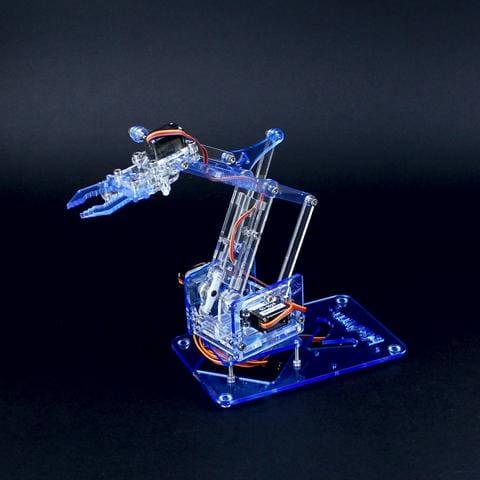
- DOF: 4
- Payload: 4 9-g servomotors
- 3D printable: Yes
The MeArm is among the most popular Arduino robot arms around, and for good reason. The MeArm has a solidly built 4DOF construction, and can be made from almost any flat 1/8th inch material, for instance Acrylic, plywood, or sheet metal.
The parts can be cut by hand or by laser, and now there are even files available to allow the parts to be 3D printed. The arm uses small 9-g hobby servos, making it perfect for Arduino, but at the same time limiting the payload.
Due to its extreme popularity and open source nature, several spin-offs exist, each with a few differences in size, shape, and lifting power, but all using the same mechanical setup. Two examples are the EEZYbotARM (which is lower down on this list) and the popular uArm robots.
Kits can be bought containing all the required MeArm parts for both Arduino and Raspberry Pi powered variations, or even just the precut parts and hardware without any electronics. Alternatively, you can build your own using the open source files the designers have distributed.
The MeArm kits are available to buy from the MeArm product page.
To build your own, check out the MeArm on Thingiverse.
LittleArm
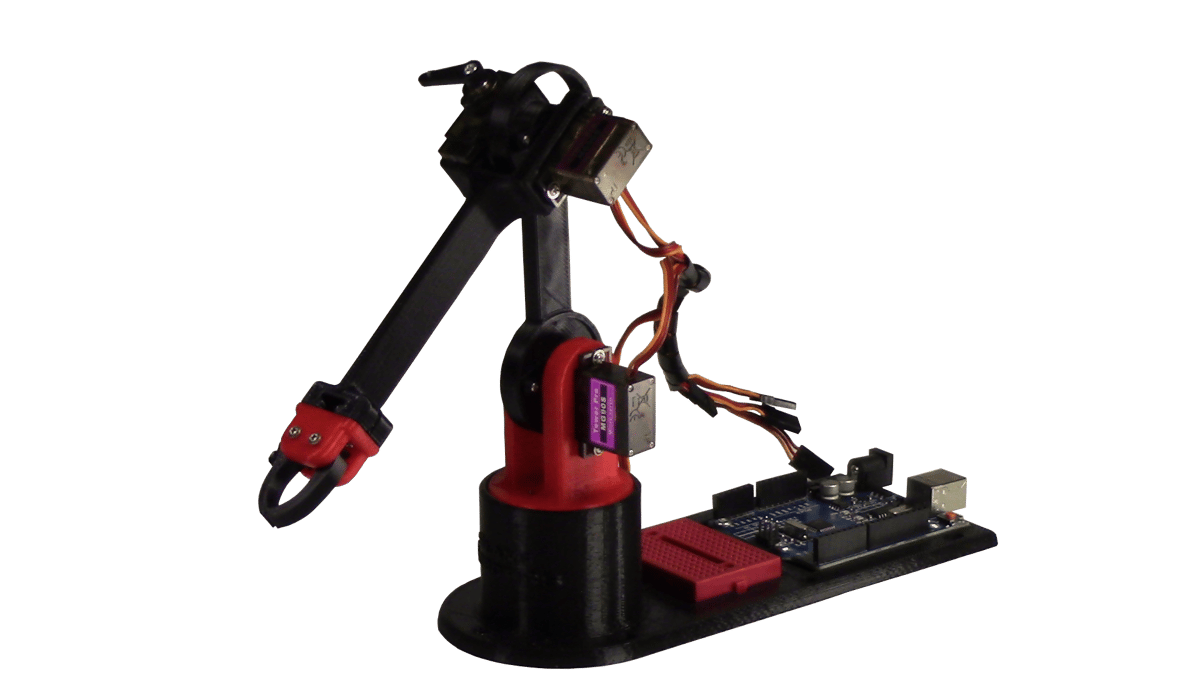
- DOF: 3
- Payload: 4 9-g servomotors
- 3D printable: Yes
Developed by Slant Concepts, the LittleArm is a very small, simple Arduino robot arm. The fully 3D printed 3DOF construction is specifically intended for educational purposes, and as far as education goes, not much can beat an Arduino for an easily configured control board, which is exactly what this arm is designed for.
Using four 9-g servos to actuate the arm and gripper, this arm has one of the simplest possible designs, allowing for effortless construction by almost anyone, partially thanks to the easy-to-follow instructions on Hackaday.io. The creators didn’t stop there, either.
Recognising the possibilities opened by having an Arduino board for the core processing and control unit, they developed an application that allows control of the LittleArm through a connected device or computer, with an impressively easy to use graphic interface.
To get your own up and running, check out both the LittleArm product page as well as the full project documentation on Hackaday.
EEZYbotARM MK2
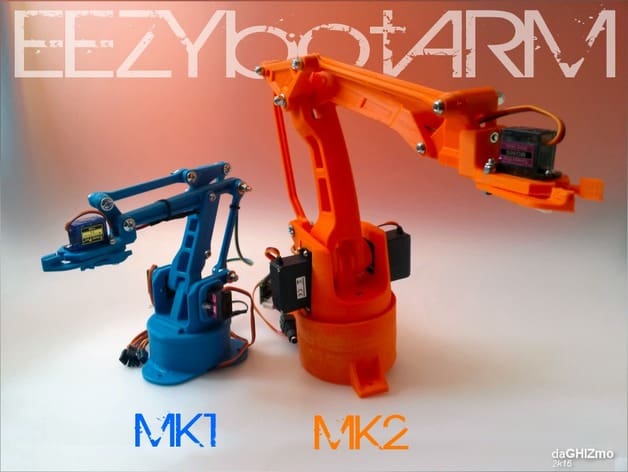
- DOF: 4
- Payload: 4 9-g servomotors
- 3D printable: Yes
The EEZYbotARM is now in its third generation of development, with the MK2 being the most recently completed (and a MK3 on the way). This Arduino robot arm is a direct variation of the 4DOF MeArm design, but, unlike the MeArm, the EEZYbotARM is designed specifically for a 3D printer, resulting in a more aesthetically pleasing and structurally sound arm overall.
Developed by daGHIZmo, the EEZYbotARM MK2 has won two contests, and is quite the powerful little machine. Instead of the little hobby servos used by most Arduino robot arms, this bot uses the more powerful (and bigger) MG90 servos, giving it an effectively larger payload than the previous two arms.
As this arm is completely open source, you can find the files to print it on the EEZYbotARM Thingiverse page and the instructions and BOM to complete your build on the EEZYrobots EEZYbotARM webpage.
RobotGeek Snapper V3
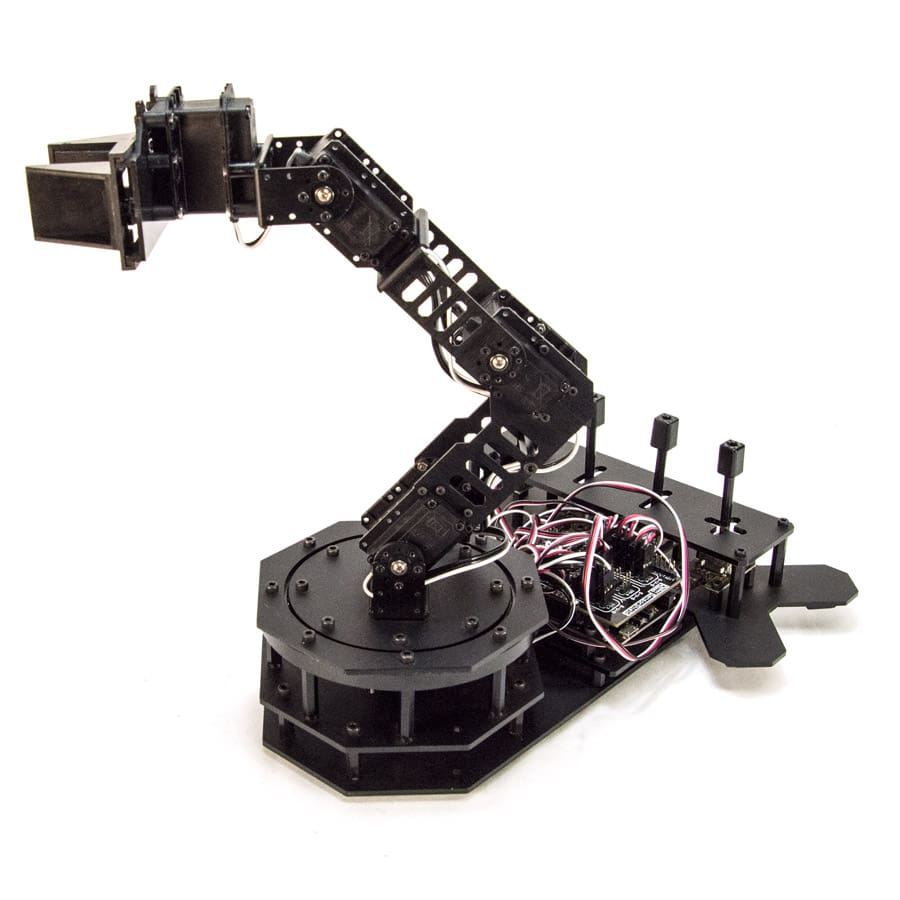
- DOF: 4
- Payload: 5 50-g servomotors
- 3D printable: No
This is the second most expensive Arduino robot arm kit on this list, and for good reason. The RobotGeek Snapper V3 is not an arm to be messed with, having a full metal 4DOF design, featuring custom built servos for a payload of over 50 grams, and a reach of around 29 cm from the shoulder to the gripper.
The arm comes with everything you need to get started, including the Geekduino/Arduino board, ships in one kit, and even includes a 3-joystick control panel. The claw uses a parallel grip system for actuation, giving this arm a firm handshake, which is to say, it has a really strong grip.
To buy your kit, take a look at the RobotGeek Snapper product page.
To learn how to use a RobotGeek Snapper V3, have a look at the online ‘getting started’ guide.
Makeblock Robot Arm Kit
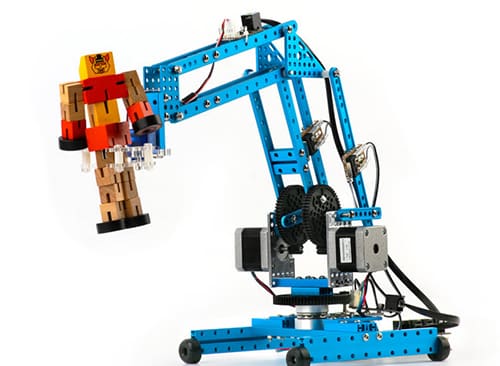
- DOF: 4
- Payload: 3 42BYG stepper motors
- 3D printable: No
Probably the biggest, most powerful Arduino robot arm on this list, the 4DOF Makeblock Robot Arm Kit is unique in its use of NEMA 17 stepper motors for the main axes.
The Arduino robot arm is designed as an educational toy, with simple plug-and-play, color coded “MegaPi” Arduino and Raspberry Pi based electronics. The construction is relatively simple and well-detailed instructions help make the process mostly painless regardless of the user.
The arm is 100% compatible with all other Makeblock kits, and all of the included hardware and components are top quality. The kit is constructed of milled metal beams for strength and reliability.
To get your own, have a look at the Makeblock Robot Arm Kit product page.